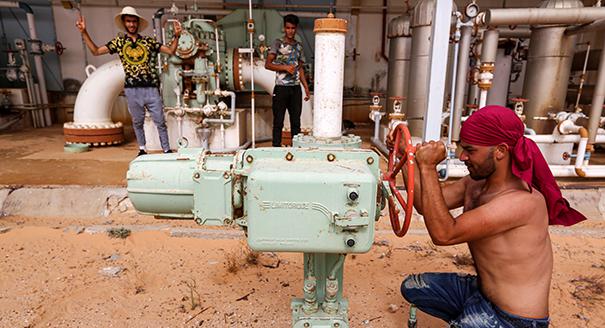Hamza Meddeb is a nonresident scholar at the Malcolm H. Kerr Carnegie Middle East Center in Beirut, where he focuses on economic reform, the political economy of conflicts, and border insecurity across the Middle East and North Africa. Recently, he published an article titled “Life on the Edge: How Protests in Tataouine Forced Tunis to Back Down,” which was widely read, particularly in Tunisia. Diwan interviewed Meddeb in mid-March to discuss his article, and more broadly to get his views on the situation in the marginalized regions of southern Tunisia, as well as future prospects there.
Michael Young: You’ve recently written an article on the 2020 protests in Tataouine, in southern Tunisia. What caused them?
Hamza Meddeb: The starting point of the protests was a demand for implementation of an agreement signed in 2017 between protestors and the government of then-prime minister Youssef Chahed. At the time, protestors had demanded jobs and regional development for Tataouine, as well as the equitable distribution of the region’s oil and gas revenues. In June of that year, protestors and the government reached an agreement that guaranteed job creation and establishment of a regional development fund. In 2020, protestors believed the government has broken its promises and resumed the campaign.
This reflected a deep crisis of trust between the central authorities and the population in the peripheries. Exacerbating this was a feeling that, despite the general elections of 2019, the political class and the central authorities were still not committed to fulfilling their pledges from 2017. The lockdown due to the Covid-19 pandemic in April and May 2020, like the consequent closure of the Libyan border that lasted throughout 2020, led to the collapse of the border economy, plunging the region into a severe economic predicament.
MY: How was oil used by protestors as a weapon in the 2020 protests?
HM: The protestors called their movement the “Kamour movement,” named for the Kamour oil pumping station located 110 kilometers from Tataouine. The station is a crucial transit point for oil by companies operating in Tunisia’s desert. In 2017, and again in 2020, protestors occupied the facility and blocked the transfer of oil. Tataouine’s oil fields contribute 20 percent of Tunisia’s gas output and 40 percent of its oil output. Oil was a crucial bargaining chip in the negotiations with the government. Also, protestors formed a coordination committee representing cities in Tataouine Governorate, as it was vital to show that all the governorate’s cities were represented in their movement in order to claim their right to benefit from oil and gas revenues.
The “weaponization” of oil was crucial to the success of the movement but was not the only explanation for its success. The population’s solidarity with the protestors was important in increasing the cost of repression by the state. Indeed, the violent security response in summer 2020 fueled local sympathy for the protests, with more people joining them. Repression was counterproductive as the movement escalated further in July 2020 when protestors threatened to prevent access to the Nawara gas field, threatening to block gas production after hindering the transfer of oil.
Oil companies operating in the region responded by warning Tunisia’s president that they might pull out of their concessions. The pressure on the protestors also rose as oil companies started reducing the salaries of permanent staff and laid off some contract workers. The protestors feared losing the approval of the population. The stakes were so high that the only option left for both sides was to negotiate and try to find a way out of the crisis. A new agreement was signed in November 2020. Oil production resumed a day after the signature of the agreement, ending a four-month shutdown.
MY: What was the outcome of the protests, and what made it different than previous ones?
HM: The agreement of November 6 fulfilled most of the protestors’ demands. The environment and planting company of Tataouine, a state body, would hire an additional 1,000 people, while oil companies would hire 285 people. Of this number, 215 were to be immediately hired by December 31, 2020. This did not happen because of delays in the recruitment process, again generating distrust. Initially, the agreement of 2017 had mentioned that oil companies would hire 1,500 people. However, this was not possible and protestors had to lower their expectations in 2020.
Also, the 2017 agreement had established an annual fund of 80 million Tunisian dinars ($29 million) dedicated to developing the region. This was reaffirmed in the 2020 agreement. The fund will be managed by the Tataouine Regional Council, which represents key state administrations in the region—education, health, infrastructure, and agriculture—and is led by the governor. The fund is supposed to finance projects to encourage entrepreneurship and diversification of the region’s economy. The government will also help to bolster small and medium enterprises in Tataouine by offering loans totaling 2.2 million Tunisian dinars ($800,000) to finance the projects of a hundred young entrepreneurs.
Overall, the 2020 agreement was more realistic than the one of 2017. However, there was still mistrust. Protests erupted in February 2021 against the delays in implementing the agreement. However, progress has since been made in this regard, which is essential to regaining the trust of the population.
MY: Just how bad has the economic situation been in southern Tunisia, traditionally a marginalized area?
HM: In 2019, Tataouine’s unemployment rate was the highest in the country at 28.7 percent, almost twice the national average of 15.3 percent. Tataouine also has one of Tunisia’s highest percentages of unemployed graduates, estimated at 58 percent in 2017. Education is neglected and universities in the cities offer limited work prospects for young graduates. Public services are of lower quality than in many other governorates. Even today, in the health sector, there are very few intensive care beds in interior and border regions, and those that exist were created after the outbreak of the Covid-19 pandemic. Tataouine’s regional hospital has only eleven specialized doctors, which is the lowest number in the county.
This situation has exacerbated Tataouine’s marginalization, reducing considerably its attractiveness for investment, which was already negligible. The Tunisian Institute of Competitiveness and Quantitative Studies warned in 2018 that Tataouine was the governorate with the lowest level of economic attractiveness.
A major aspect of the systemic crisis in Tataouine is the tribal land tenure system. Thirty percent of land is subject to collective tenure and is managed by tribal councils, hindering privatization. Fragmentation of land ownership among tribes and communal disputes over land have discouraged investment, obstructing the development of alternatives to oil and gas.
The result of all this has been a multilayered crisis and a deep feeling of neglect among the population. The Covid-19 pandemic and the closure of the border intensified the crisis and the push factors driving migration. Thousands of young people from southern border areas migrated, or tried to migrate, to Europe in 2020. An estimated 11,000 undocumented migrants, many of them from southern Tunisia, reached Italian shores between January 1 and October 31.
MY: Do you foresee any amelioration in the situation in southern Tunisia in the near future, or is the south’s marginalization a structural issue that would require overhauling the entire hierarchy of power in the country, which is very difficult?
HM: The south’s marginalization is a structural issue. Reversing this would require rethinking Tunisia’s development and governance model toward more decentralization and the building of a genuine development strategy at the local level. The challenge for Tataouine will be to diversify its local economy away from oil, encourage entrepreneurship, and resolve land tenure issues, but also to think of cross-border cooperation opportunities with Libya. A regional development strategy based on attracting large non-oil investment to foster private enterprise and reforming land tenure is essential for improving the region’s attractiveness. Speeding up the process of decentralization is key in that it will foster local decisionmaking and the legitimacy of state authorities at the local level.







